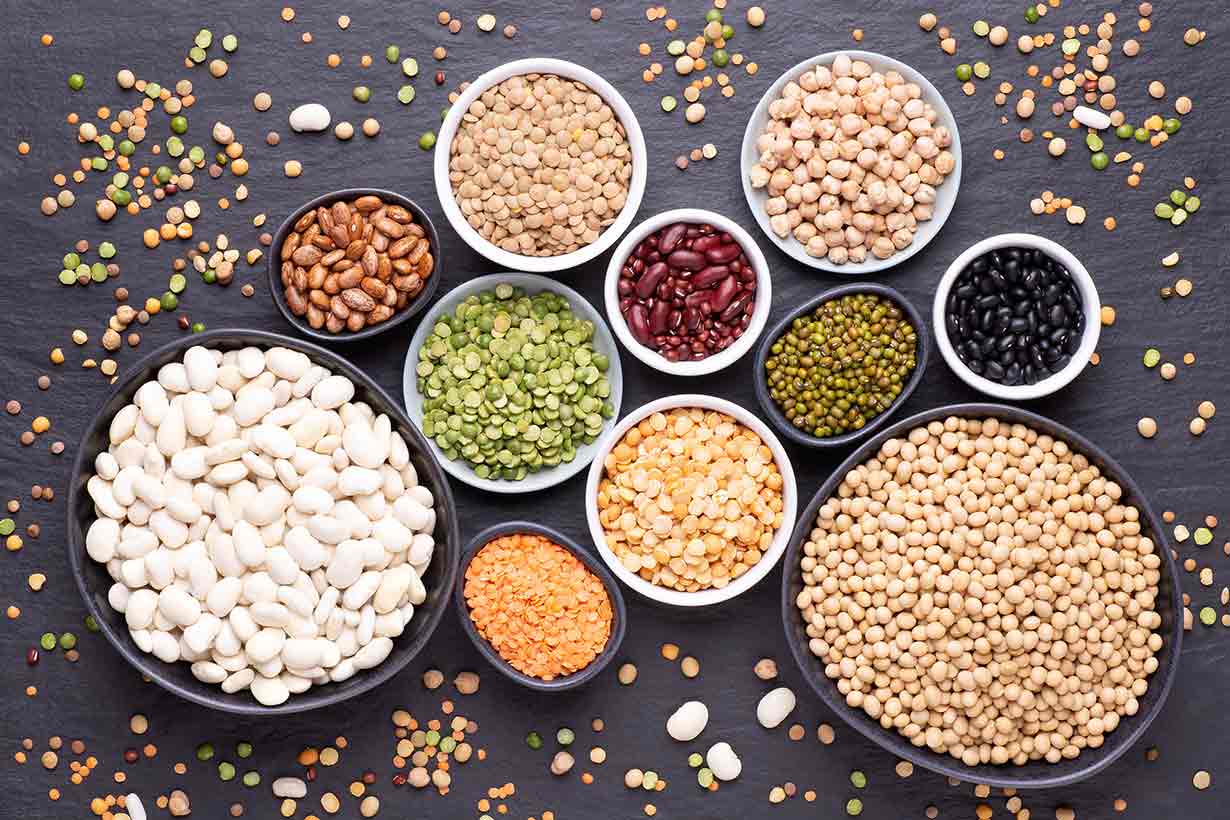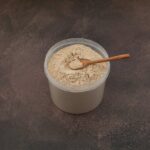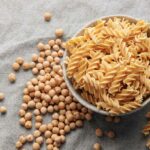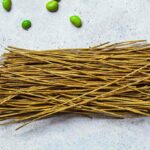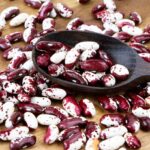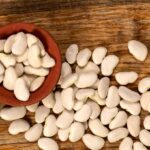Black bean pasta is one of the new legume-based pasta options offering a nutritional upgrade to traditional pasta.
With more protein and fiber, black bean pasta is becoming increasingly popular, but what else does it provide nutritionally?
This article explores black bean pasta’s nutritional profile, benefits, and potential downsides.
Table of contents
The Nutritional Values of Black Bean Pasta
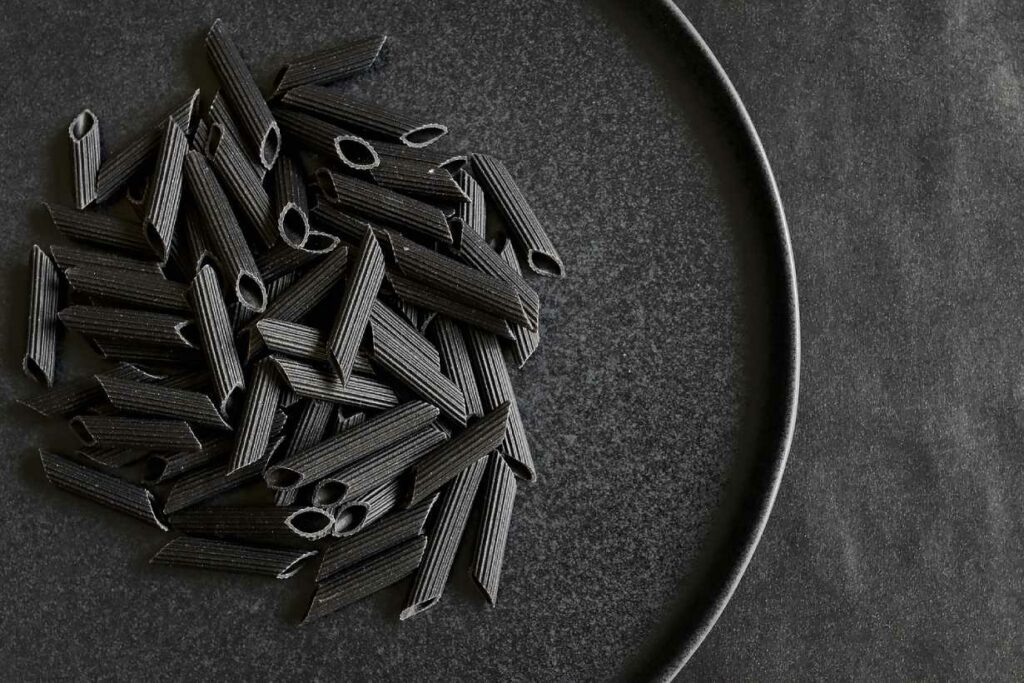
Firstly, let’s examine the nutritional values of black bean pasta.
Unfortunately, there are no entries for black bean pasta’s complete nutritional profile (including vitamins and minerals) in trustworthy nutritional databases.
However, the USDA database has the basic nutrition facts for ‘Black Bean Spaghetti’ by the brand Bellabondonza. This product is a pure black bean pasta, with the only ingredients being black bean flour and water.
The following table shows the basic nutritional profile of black bean pasta per 3.5 ounces (100 grams) dry weight (1).
Percent Daily Values (% DV) have been calculated using the FDA’s published daily values (2).
| Name | Amount | % Daily Value |
|---|---|---|
| Calories | 321 kcal | |
| Carbohydrates | 30.4 g | 11.1% |
| Fiber | 21.4 g | 76.4% |
| Sugars | 8.93 g | |
| Fat | 3.57 g | 4.6% |
| Saturated | 1.79 g | |
| Protein | 44.6 g | 89.2% |
| Cholesterol | 0 mg | 0% |
| Sodium | 4 mg | 0.2% |
This nutritional data shows that black bean pasta provides substantial dietary fiber and protein.
Vitamins and Minerals
The vitamin and mineral composition of black bean pasta is not listed in the USDA database. However, the Canadian Nutrient File contains data for black bean flour, shown below.
Please note that these won’t be the exact amounts found in black bean pasta, which is made by mixing black bean flour with water. That said, it should still provide an idea of which vitamins and minerals black bean pasta provides in high amounts.
Here is the vitamin and mineral data for 100 grams of black bean flour (3):
Vitamins
- Vitamin A, RAE: 0 mcg (0% DV)
- Folic acid, DFE: 473 mcg (118% DV)
- Vitamin B1 (thiamin): 0.96 mg (80% DV)
- Vitamin B2 (riboflavin): 0.21 mg (16% DV)
- Vitamin B3 (niacin): 2.08 mg (13% DV)
- Vitamin B5 (pantothenic acid): 0.96 mg (19% DV)
- Vitamin B6: 0.3 mg (18% DV)
- Vitamin B12: 0 mcg (0% DV)
- Vitamin C: 0 mg (0% DV)
- Vitamin D: 0 mcg (0% DV)
- Vitamin E: 0.23 mg (2% DV)
- Vitamin K: 6.4 mcg (5% DV)
From the vitamin profile of black bean flour, we can note that black bean pasta contains significant folic acid and thiamin content.
Minerals
- Calcium: 131 mg (10% DV)
- Copper: 0.9 mg (100% DV)
- Iron: 5.34 mg (30% DV)
- Magnesium: 182 mg (43% DV)
- Manganese: 1.13 mg (49% DV)
- Phosphorus: 375 mg (30% DV)
- Potassium: 1578 mg (34% DV)
- Selenium: 3.4 mcg (6% DV)
- Sodium: 5 mg (<1% DV)
- Zinc: 3.89 mg (35% DV)
As the mineral profile of black bean flour shows, black bean pasta is a rich source of copper, magnesium, manganese, zinc, potassium, phosphorus, and iron.
Benefits of Black Bean Pasta
Due to its nutritional composition, black bean pasta may have several health benefits.
Here is a summary of these potential benefits alongside supportive references.
Lower glycemic index: better for blood sugar control
Foods with a lower glycemic index have a smaller impact on blood sugar levels (4, 5).
In this regard, a glycemic index value of 100 would substantially impact blood sugar, whereas a score of 1 would have little effect.
On this note, traditional wheat pasta has a glycemic index value of 49, according to the International Tables of Glycemic Index (6).
There is currently no research on black bean pasta’s glycemic index.
However, black bean pasta likely has a much lower glycemic index than traditional pasta. For instance, several studies show that whole black beans have a glycemic index in the region of 20-31 (7, 8, 9).
As a legume-based product, black bean pasta likely has a glycemic index more similar to other legume pasta like chickpea (23) and red lentil pasta (22).
In other words, this means that black bean pasta would have a lesser impact on blood sugar levels than traditional pasta.
Lower glycemic responses to black bean pasta are supported by a randomized controlled trial published in 2020. In this study involving fifteen healthy adults, black bean pasta meals had a significantly lower glycemic response than white bread (wheat flour) control meal (10).
Individuals with type 2 diabetes or otherwise trying to regulate their blood sugar better may benefit from a lower glycemic pasta choice (11). However, any dietary changes should always be discussed with a healthcare professional for those with medical conditions and using medications.
Higher in protein and fiber: may promote satiety and digestive health
Black bean pasta is significantly higher in dietary protein and fiber than wheat pasta.
Per 100 grams (dry weight), black bean pasta has 44.6 grams of protein and 21.4 grams of fiber (1).
In contrast, traditional wheat pasta only contains 13 grams of protein and 3.2 grams of fiber for the same 100 grams (12).
To put it another way, black bean pasta has over thirty grams more protein and almost 20 grams more fiber than wheat pasta per 100 grams of dry weight.
Satiety
On a related note, research suggests that fiber and protein may help to promote satiety, the feeling of being full after eating (13, 14, 15, 16).
Based on this, it is possible that switching to black bean pasta may help to lower appetite compared to regular wheat pasta. Improved satiety and lower appetite are two factors that likely have a positive impact on weight management (17).
Furthermore, a randomized controlled trial published in 2022 found that black bean pasta meals “increased satiety and reduced appetite” compared to a white bread control meal (18).
Digestive health
Fiber can also have a range of benefits for digestive health.
For example, research has shown that higher intakes of dietary fiber increase the abundance of “good” Bifidobacteria in the gut (19).
Bifidobacteria are a type of microbe found in the gastrointestinal tract that is thought to confer benefits to their host (20).
Additionally, dietary fiber is capable of binding to and excreting potential carcinogens in the intestinal tract (21).
May have benefits for heart health
Black bean pasta is a rich source of soluble fiber, which research has consistently shown can lower “bad” LDL cholesterol (LDL-C) levels (22, 23, 24).
Higher levels of LDL-C, and more accurately, the apolipoprotein B particles that LDL-C carries in the blood, are a risk factor for developing cardiovascular disease (25, 26).
Based on current understanding, replacing saturated fats or starchy carbohydrates with fiber-rich carbohydrates like black bean pasta would have an LDL-C lowering effect (27, 28).
Black bean pasta is a gluten-free pasta option
Millions of people worldwide have celiac disease, a condition in which the body has an immune reaction to a protein called gluten. This immune response can progressively damage the small intestine (29).
Many people also have a condition known as non-celiac gluten sensitivity (sometimes called gluten intolerance). While not as severe as celiac disease, digestive issues such as bloating can appear after consuming gluten for those with intolerance (30).
Wheat is one of the primary dietary sources of gluten, thus making traditional wheat pasta unsuitable for anyone with celiac disease or gluten intolerance (31).
Neither black beans nor black bean pasta contains gluten, making it a suitable gluten-free alternative to wheat pasta.
Note: black bean pasta products made solely with black bean flour are gluten-free. However, it is worth checking the label ingredients to ensure no additional wheat flour is in the product.
For more gluten-free pasta choices, see this guide to edamame pasta.
A nutritional upgrade to traditional pasta
If we compare black bean pasta to any food, that food should be the most popular pasta product; traditional “white” wheat pasta.
In this regard, how do the two compare?
The following table provides an at-a-glance comparison between the two per 100 grams of dry weight (1, 12):
| Nutrient | Black Bean Pasta | Wheat Pasta |
|---|---|---|
| Calories | 321 kcal | 371 kcal |
| Carbohydrates | 30.4 g | 74.7 g |
| Fiber | 21.4 g | 3.2 g |
| Sugars | 8.93 g | 2.67 g |
| Fat | 3.57 g | 1.51 g |
| Saturated | 1.79 g | 0.28 g |
| Protein | 44.6 g | 13.0 g |
The data shows that black bean pasta:
- Has significantly fewer calories than wheat pasta.
- Contains fewer carbohydrates but significantly more fiber.
- Has a substantially higher protein content.
Potential Downsides and Other Considerations
As with all foods, black bean pasta has some potential, context-specific downsides.
Black bean allergy
Although not as common as allergies to legumes such as soybean and peanut, allergic reactions to other beans are possible, even if relatively rare (32).
Anyone who feels they may have an allergy to black beans or other beans should discuss the issue with a healthcare professional.
Digestive issues from quickly increasing fiber intake
As discussed earlier in this article, black bean pasta has a high fiber content.
In this context, rapidly increasing dietary fiber intake can occasionally lead to symptoms of digestive discomfort. These symptoms may include bloating, cramping, and gas (33).
Slowly and more gradually increasing fiber intake can help the digestive system to adapt and thus limit such digestive issues (34).
Tastes different from traditional pasta
Taste and enjoyment of food are important; people don’t want to eat in a way they don’t enjoy.
One potential issue in this regard is that black bean pasta has a much earthier flavor than traditional pasta and a chewier texture.
It certainly doesn’t taste bad, but it does taste different from traditional pasta for those who may be used to it. The taste characteristics are somewhat similar to wholewheat pasta and chickpea pasta.
Interestingly, a 2019 study looked into bean pasta’s ‘consumer acceptability.’ The study found that participating consumers preferred the flavor and texture of wheat pasta. However, 8-14% said they would purchase bean pasta, while 42-43% said they would possibly purchase one (35).
How To Prepare Black Bean Pasta
Lastly, here is an overview of how to prepare black bean pasta.
Time needed: 15 minutes
Black bean pasta preparation steps.
- Add water to a pot
Add 1 liter of water to a pot for every 100 grams of dry-weight pasta you intend to use. Do not put the pasta in the pot at this stage.
- Bring to a boil
Turn the hob to a high temperature to bring the water to a boil.
- Add the pasta
Once the water is boiling, add the pasta to the pot.
- Simmer
After adding the pasta, reduce the heat and simmer for approximately 7-9 minutes. The lower end of this timeframe will leave the pasta with a firmer “al dente” texture. In contrast, simmering for a few more minutes will produce a softer texture.
- Drain and serve (or use)
Once cooked as desired, drain the pasta to remove any excess water. After this, the pasta can be served, mixed with a sauce, or used in a dish. It is a versatile ingredient you can use in any recipe calling for pasta.
Final Thoughts
All in all, black bean pasta is an excellent pasta option for those looking for:
- More protein and fiber
- A gluten-free pasta option
- Pasta with a lower calorie count
- A pasta choice that likely promotes satiety more than traditional pasta
It is an easy like-for-like alternative to wheat pasta that tastes slightly different but offers more nutritionally.

